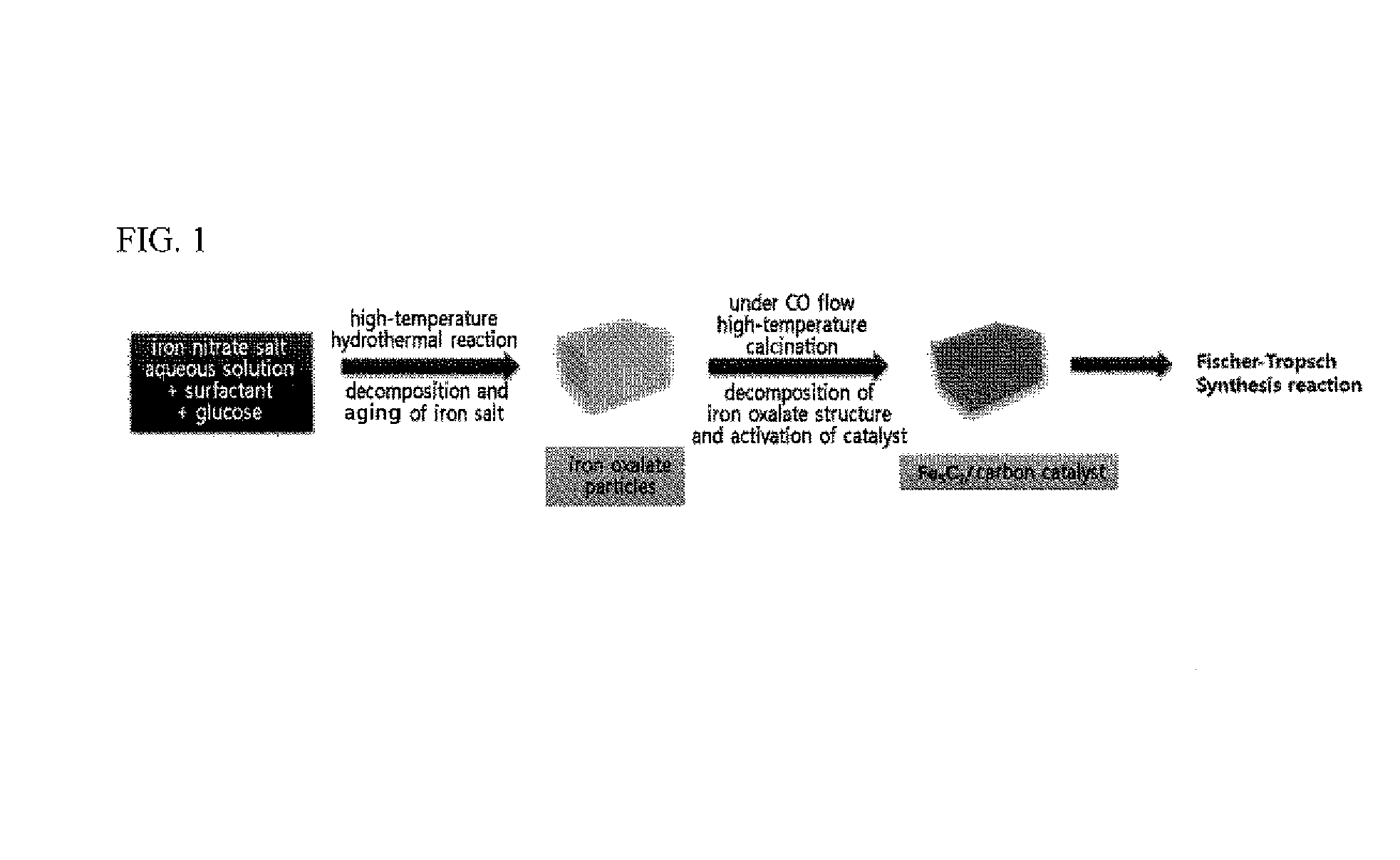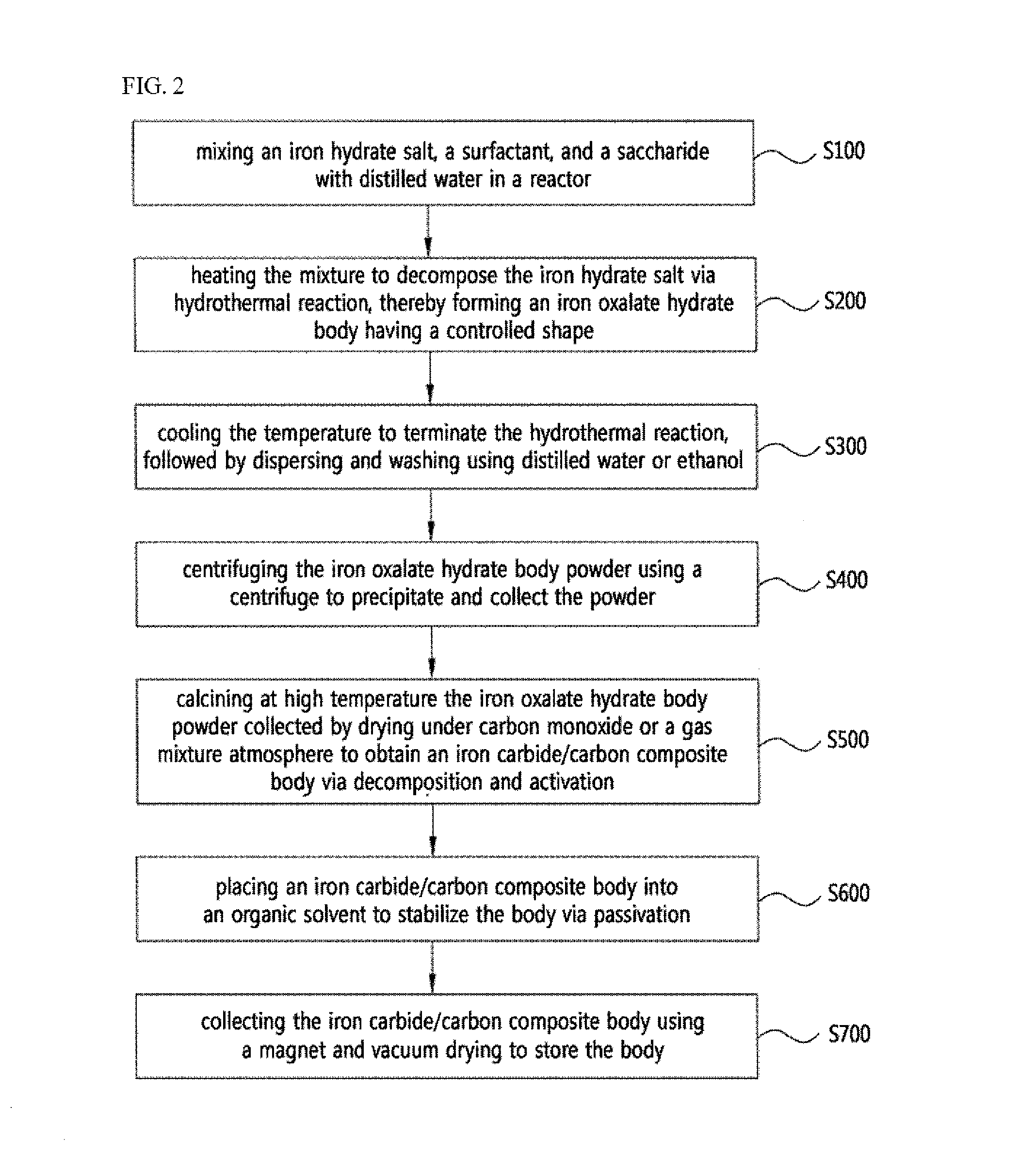Metal carbide/carbon composite body having porous structure by three-dimensional connection of core-shell unit particles, preparation method thereof, and use of the composite body
a composite body and metal carbide technology, applied in the field of metal carbide/carbon composite body having a porous structure, can solve the problems of scaling up, difficult to obtain fe/sub>5/sub>c/sub>particles, and the reactivity of ft synthesis has not been well reported
- Summary
- Abstract
- Description
- Claims
- Application Information
AI Technical Summary
Benefits of technology
Problems solved by technology
Method used
Image
Examples
example 2
Synthesis of Cube-Type Iron Oxalate Body Via Hydrothermal Reaction and Conversion Thereof into Highly Active Iron Carbide / Carbon Catalyst
[0113]The iron oxalate hydrate body was prepared by the same method as in Example 1, except that the hydrothermal reaction was carried out at 100° C. for 26 hours.
[0114]The iron oxalate powder dried after precipitation was introduced into a tubular calcinator, and was subjected to heat treatment at 300° C. and 400° C., respectively, for 4 hours under a carbon monoxide gaseous atmosphere (atmospheric pressure, velocity at 100 mL / min to 200 mL / min) to obtain a Fe5C2 / carbon nanocomposite catalyst.
[0115]As shown in FIGS. 4a and 4b, when the heat treatment was carried out at 300° C., it was observed that the cube-type structures were not properly maintained and some branched structures were formed (FIG. 4a), and the iron oxalate was not sufficiently reduced to iron carbide particles (FIG. 4b).
[0116]In contrast, when the heat treatment was carried out at...
example 3
Synthesis of Highly Active Iron Carbide Catalyst Via Hydrothermal Reaction
[0117]The iron oxalate hydrate body was prepared by the same method as in Example 1, except that 5 g of Fe(NO3)3.9H2O salt, 4.18 g (three equivalent) of PVP, 4.5 g of glucose, and 25 mL of distilled water were used, and the hydrothermal reaction was carried out at 100° C. for 26 hours.
[0118]As a result, it was confirmed that variations on the synthesis time and the synthesis scale generally did not have a significant impact on the shape of the cubic particles, compared to the experimental conditions of Examples 1 and 2. Further, the thus-obtained iron oxalate body underwent high-temperature calcination again at 350° C. for 4 hours under a carbon monoxide atmosphere and was converted to a Fe5C2 / carbon nanocomposite catalyst.
[0119]The Fe5C2 / carbon nanocomposite catalyst powder obtained is readily oxidized upon exposure to air, and thus, immediately after activation to iron carbide, an atmosphere was created to p...
example 4
High-Temperature FT Synthesis Using Fe5C2 / Carbon Body Catalyst Converted from Iron Oxalate Body
[0121]The high-temperature FT synthesis was carried out using an automated system in a fixed bed reactor introduced with the Fe5C2 / carbon catalyst obtained in Example 3.
[0122]60 mg of the catalyst was loaded onto a reactor immediately after drying, for the use thereof, wherein the reactor has an inner diameter of 5 mm. 4.2 g of glass bead was further added to prevent the formation of a hot spot in the catalyst due to severe exothermic reaction.
[0123]After loading of the catalyst, it was further activated at atmospheric pressure under a carbon monoxide atmosphere (40 mL / min) to recover some parts of the oxidized catalyst surfaces as pure iron carbide.
[0124]Then, syngas in which the ratio between hydrogen to carbon monoxide was maintained as 1:1 was introduced into the reactor under the conditions with a reaction pressure of 15 atm and a gas hourly space velocity (GHSV) of 40 NL / G(cat)-h, an...
PUM
| Property | Measurement | Unit |
|---|---|---|
| diameter | aaaaa | aaaaa |
| diameter | aaaaa | aaaaa |
| temperature | aaaaa | aaaaa |
Abstract
Description
Claims
Application Information
 Login to View More
Login to View More - R&D
- Intellectual Property
- Life Sciences
- Materials
- Tech Scout
- Unparalleled Data Quality
- Higher Quality Content
- 60% Fewer Hallucinations
Browse by: Latest US Patents, China's latest patents, Technical Efficacy Thesaurus, Application Domain, Technology Topic, Popular Technical Reports.
© 2025 PatSnap. All rights reserved.Legal|Privacy policy|Modern Slavery Act Transparency Statement|Sitemap|About US| Contact US: help@patsnap.com



